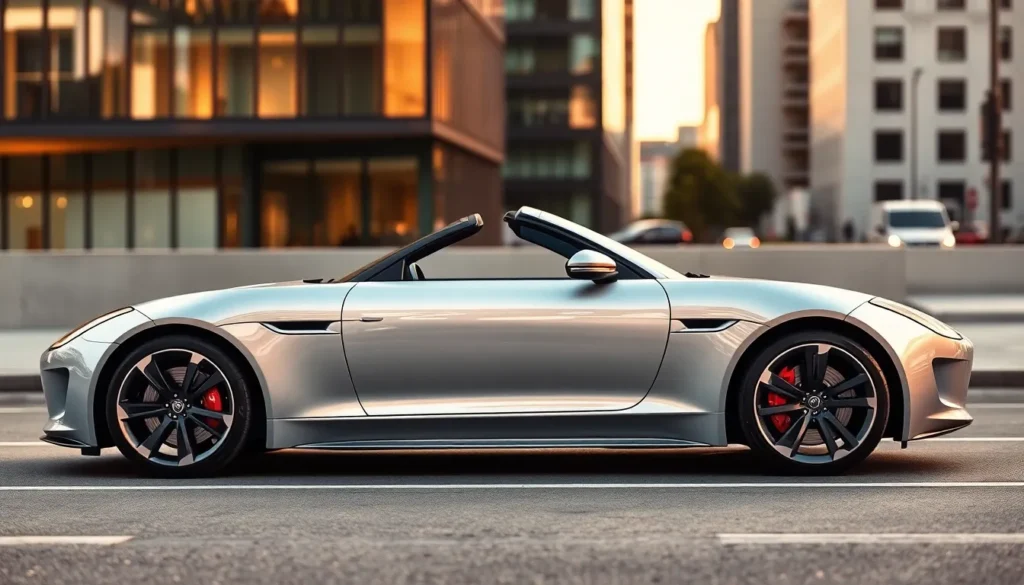When we think of automotive elegance and timeless design, Jaguar’s distinctive aesthetic immediately comes to mind. The British luxury brand has masterfully crafted vehicles that seamlessly blend sophistication with raw power, creating an unmistakable visual identity that’s captivated car enthusiasts for decades.
We’ve witnessed Jaguar’s design evolution transform from the sleek curves of classic E-Types to today’s modern marvels like the F-Type and I-PACE. Each model showcases the brand’s commitment to creating vehicles that aren’t just transportation—they’re rolling works of art that command attention on every street corner.
What sets Jaguar’s aesthetic apart isn’t just its stunning exterior lines or luxurious interior craftsmanship. It’s the way these elements work together to create an emotional connection between driver and machine. From the iconic leaping cat emblem to the distinctive grille design, every detail contributes to an automotive experience that’s both visually striking and deeply satisfying to own.
The Evolution of Jaguar’s Design Language
Jaguar’s aesthetic journey spans seven decades of automotive innovation and artistic refinement. Each era brought distinct design philosophies that shaped the brand’s visual identity while maintaining its core essence of elegance and performance.
Classic Era: E-Type and XK Series
Classic Jaguar design emerged in the 1960s with the revolutionary E-Type, which established the brand’s signature aesthetic language. Enzo Ferrari famously called it “the most beautiful car ever made” when production began in 1961. The E-Type featured flowing lines, an elongated hood, and curvaceous rear haunches that became hallmarks of jaguar car aesthetic excellence.
Key design elements from this period include:
- Long bonnet proportions with graceful curves
- Distinctive oval grille with chrome surround
- Wire-spoke wheels as standard equipment
- Minimal brightwork emphasizing body lines
- Glass greenhouse positioned far rearward
XK120, XK140, and XK150 models preceded the E-Type and introduced fundamental styling cues that endure today. These vehicles showcased muscular fender flares, chrome bumpers integrated into the body design, and the iconic leaping jaguar mascot. Malcolm Sayer’s aerodynamic expertise influenced every curve and surface during his tenure as chief designer from 1950 to 1970.
Modern Transformation: XF and XJ Revival
Modern Jaguar design language underwent dramatic transformation in 2007 with Ian Callum’s appointment as Design Director. The XF sedan launched in 2008 and revolutionized the brand’s visual approach with contemporary interpretations of classic elements. Bold shoulder lines replaced the gentle curves of previous generations while maintaining jaguar car aesthetic DNA.
Transformation elements included:
- Coupe-like rooflines on four-door sedans
- LED lighting signatures creating distinctive visual identity
- Enlarged grilles with mesh patterns replacing horizontal bars
- Sculpted side surfaces with pronounced character lines
- Interior layouts featuring rotary gear selectors
XJ flagship received complete redesign in 2009, abandoning retro styling for forward-thinking aesthetics. Aluminum construction enabled cleaner proportions while advanced manufacturing techniques allowed complex surface treatments. The model retained classic Jaguar proportions but expressed them through modern design vocabulary that attracted younger buyers to the brand.
Contemporary Vision: F-Type and I-PACE
Contemporary Jaguar aesthetics reached new heights with the F-Type sports car introduction in 2013. This model directly referenced E-Type design cues while incorporating 21st-century technology and manufacturing capabilities. Muscular haunches, a distinctive waistline, and aggressive front fascia created instant recognition as a true jaguar car aesthetic masterpiece.
F-Type design characteristics:
- Clamshell hood extending to wheel arches
- Side vents positioned behind front wheels
- Wraparound rear glass connecting to side windows
- Quad exhaust outlets integrated into rear valance
- Retractable door handles maintaining clean surfaces
I-PACE electric SUV launched in 2018 and represented Jaguar’s vision for sustainable luxury performance. The vehicle abandoned traditional proportions required by internal combustion engines, creating space for innovative design answers. Aerodynamic efficiency drove every surface decision while maintaining brand recognition through signature lighting and grille treatments.
- Cab-forward architecture maximizing interior space
- Black roof panels creating floating appearance
- Flush door handles reducing aerodynamic drag
- Through-hood ventilation channels cooling batteries
- Distinctive rear spoiler integrating with tailgate design
Signature Jaguar Design Elements
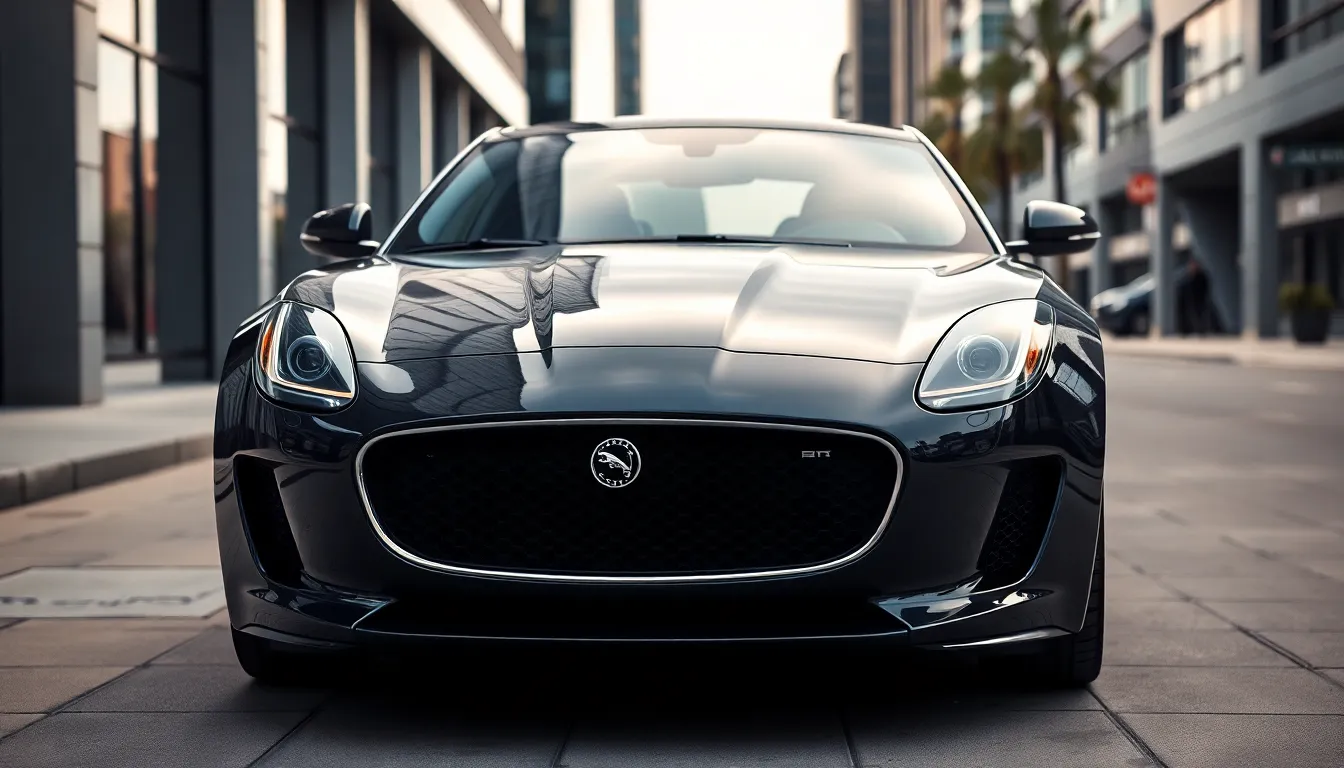
Jaguar car aesthetic centers on three fundamental design elements that define the brand’s visual identity across all models. These distinctive features create an unmistakable presence that distinguishes every Jaguar from competitors in the luxury automotive market.
The Iconic Leaper Hood Ornament
The leaping jaguar hood ornament represents the most recognizable symbol in automotive history. This chrome-finished sculpture first appeared on Jaguar vehicles in 1945 and captures the essence of power, grace, and forward momentum that defines the brand’s character.
Modern Jaguar models feature two distinct versions of the leaper design. The traditional three-dimensional ornament adorns select premium models like the XJ and F-Type, while contemporary vehicles incorporate a flat badge interpretation for improved aerodynamics and safety regulations.
Craftsmen hand-polish each leaper ornament using a specialized seven-step process that ensures consistent quality and finish. The ornament measures 4.5 inches in length and positions at a precise 15-degree angle to create the illusion of movement even when the vehicle remains stationary.
Distinctive Grille and Headlight Design
Jaguar’s signature grille features a distinctive oval shape that has evolved consistently since the 1950s. The mesh pattern incorporates hexagonal cells that vary in size from 8mm at the center to 12mm at the outer edges, creating a gradient effect that enhances the grille’s three-dimensional appearance.
Contemporary Jaguar models integrate LED headlight technology with distinctive J-blade daytime running lights. These signature lighting elements form a sharp, angular pattern that extends from the headlight housing toward the grille, creating visual continuity across the front fascia.
The grille’s chrome surround measures 2mm in thickness and receives a specialized coating process that provides UV protection and maintains its lustrous finish. Black mesh inserts contrast against the chrome framework, emphasizing the grille’s depth and sophistication.
Flowing Body Lines and Proportions
Jaguar designers employ mathematical principles to create the brand’s characteristic flowing body lines. The golden ratio (1.618:1) governs the relationship between key proportional elements including hood length, cabin height, and rear deck dimensions.
Classic Jaguar proportions feature an elongated hood that comprises 45% of the vehicle’s total length. This extended front section houses the engine while creating an elegant profile that suggests power and performance capabilities.
Body side sculpting incorporates subtle concave surfaces that capture and reflect light dynamically. These carefully crafted surfaces create shadow lines that accentuate the vehicle’s muscular stance while maintaining aerodynamic efficiency with drag coefficients typically ranging from 0.28 to 0.31.
The roofline follows a gentle arc that peaks directly above the driver’s position before tapering toward the rear. This profile creates a coupe-like silhouette even on four-door sedan models, reinforcing Jaguar’s sporting character across the entire model range.
Interior Aesthetics and Craftsmanship
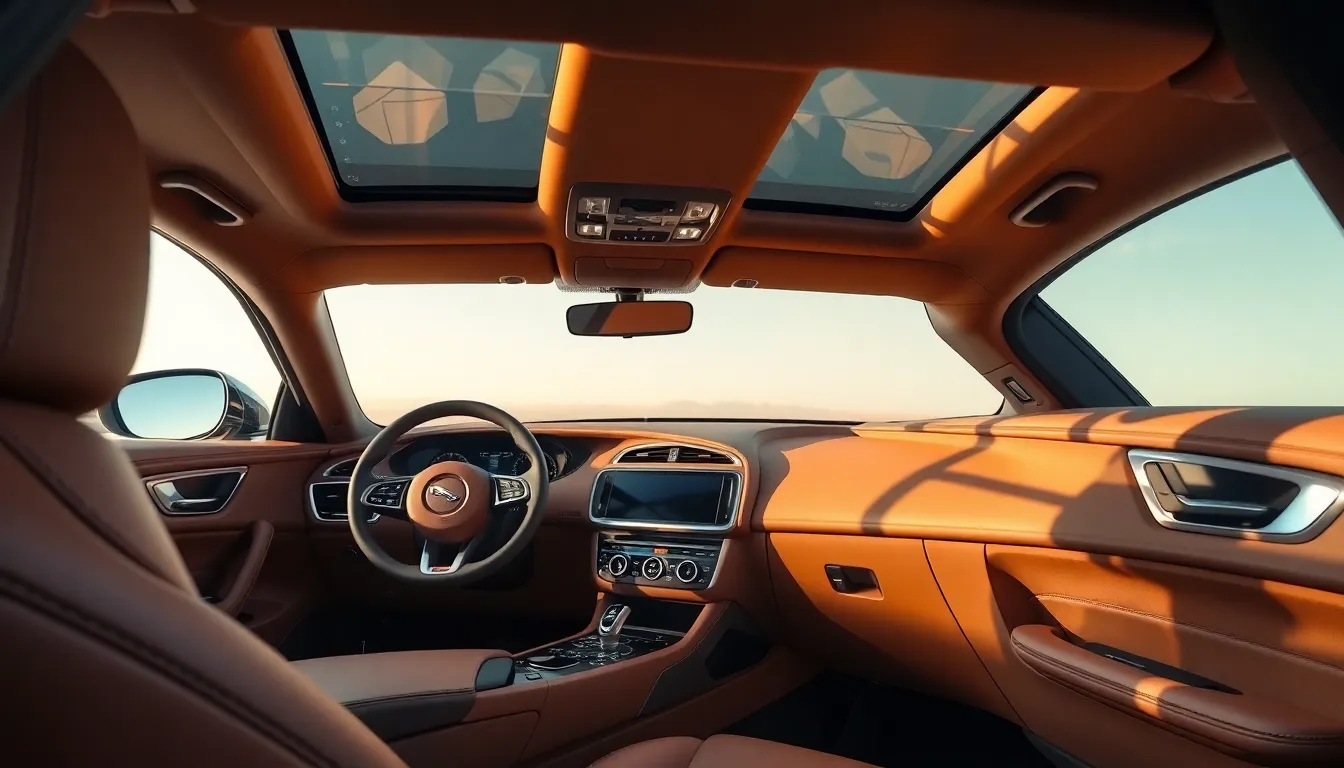
Jaguar’s interior design philosophy transforms automotive cabins into sophisticated sanctuaries where luxury materials meet functional artistry. Each element within the passenger compartment reflects the brand’s commitment to creating an immersive driving experience that matches the exterior’s elegant proportions.
Luxurious Materials and Finishes
Premium leather surfaces define Jaguar’s interior aesthetic approach, with Oxford leather offering supple textures across seating surfaces and door panels. Hand selected veneers from sustainable forests create distinctive grain patterns that complement the leather’s natural warmth. Windsor leather represents the pinnacle of Jaguar’s material hierarchy, featuring diamond quilted patterns and contrast stitching that emphasize the brand’s attention to detail.
Aluminum trim pieces provide contemporary accents throughout the cabin, with brushed finishes creating subtle light reflections that enhance spatial depth. Carbon fiber options deliver sporty sophistication in performance oriented models like the F Type, while traditional walnut veneers maintain classic British elegance in luxury sedans. Soft touch materials cover every contact point, ensuring tactile quality matches visual refinement across all interior surfaces.
Cockpit Inspired Dashboard Layout
The driver focused cockpit design creates an intuitive command center that prioritizes essential controls within easy reach. Jaguar’s InControl Touch Pro system integrates seamlessly into the dashboard architecture, featuring a 10 inch curved glass display that appears to float above the center console. Rotary gear selectors rise from the console when the engine starts, adding theatrical elements to the driving ritual.
Analog gauges maintain traditional aesthetics while incorporating digital displays for modern functionality, creating a bridge between heritage design and contemporary technology. The instrument cluster features customizable lighting that adapts to ambient conditions and driving modes, with white illumination for comfort settings and red accents for ever-changing configurations. Physical climate controls remain separate from touchscreen functions, ensuring drivers can adjust temperature and airflow without diverting attention from the road.
British Heritage in Modern Comfort
Traditional British craftsmanship techniques blend with advanced manufacturing processes to create interiors that honor Jaguar’s Coventry origins. Skilled artisans hand stitch leather surfaces using techniques passed down through generations, while modern ergonomic research informs seating geometry and support structures. The result combines time honored quality with contemporary comfort expectations.
Heritage inspired details appear throughout the cabin, including Union Jack motifs subtly integrated into seat perforations and tread plates that reference iconic Jaguar models. Modern amenities like heated and ventilated seating, ambient lighting systems, and premium audio components from Meridian enhance comfort without compromising the classic British atmosphere. Four zone climate control systems ensure optimal conditions for all passengers while maintaining the refined ambiance that defines the Jaguar interior experience.
Color Palettes and Customization Options
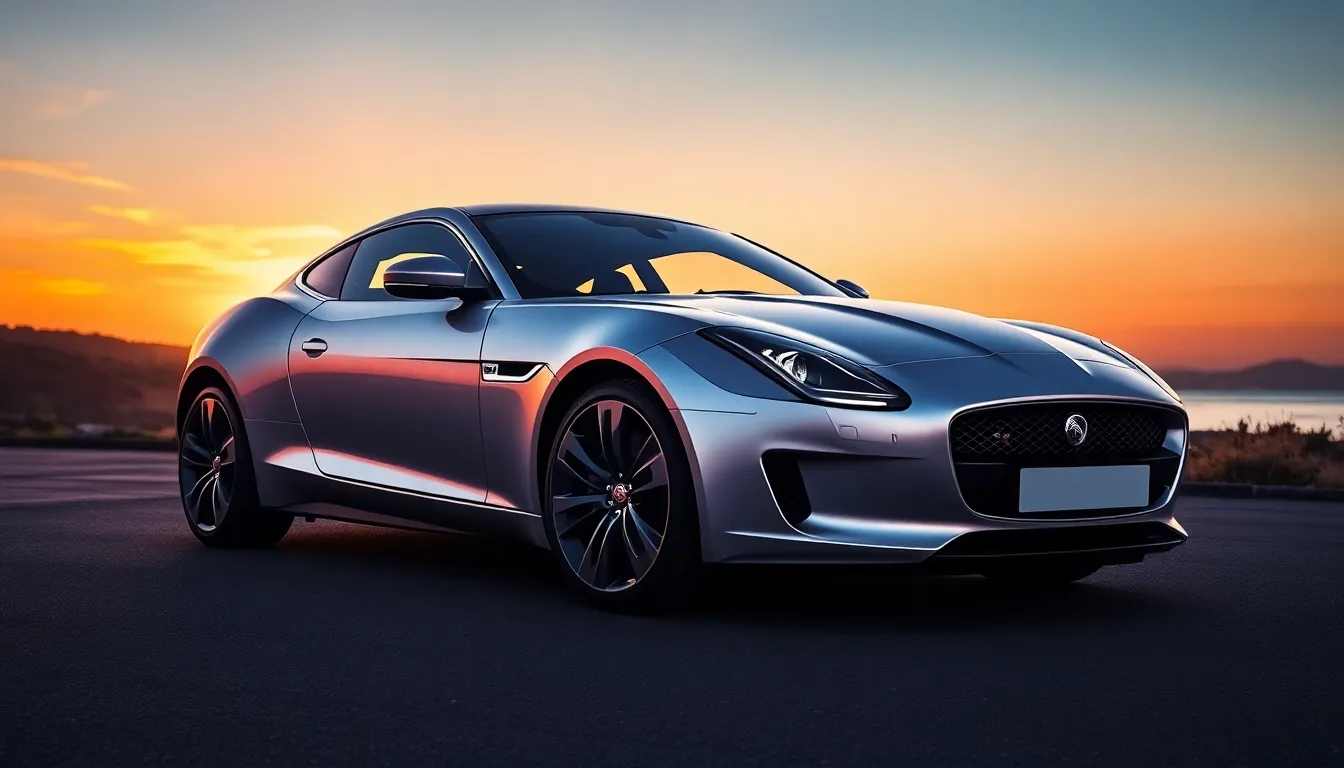
Jaguar’s paint palette reflects the brand’s commitment to sophisticated elegance through carefully curated color choices that complement the flowing design lines. Each hue enhances the vehicle’s sculptural qualities while maintaining the distinctive British luxury character.
Classic Jaguar Colors
British Racing Green stands as Jaguar’s most iconic color choice, establishing the brand’s motorsport heritage since the 1950s racing circuits. This deep emerald shade creates dramatic contrast against chrome details and emphasizes the car’s muscular proportions.
Opalescent Silver Metallic represents timeless sophistication through its subtle shimmer that shifts between platinum and pearl tones depending on lighting conditions. The color accentuates every curve and crease in Jaguar’s bodywork while projecting understated luxury.
Santorini Black provides maximum visual impact by creating striking silhouettes that highlight the car’s architectural lines. This premium black finish amplifies the vehicle’s presence on the road while showcasing chrome and aluminum trim elements.
Caldera Red delivers passionate intensity through its rich burgundy undertones that capture light differently throughout the day. The color emphasizes Jaguar’s sporty character while maintaining the refined elegance expected from British luxury vehicles.
Modern Paint Technologies and Finishes
Premium Lustrous paints incorporate advanced polymer technology that creates exceptional depth and clarity in every color application. These finishes resist environmental damage while maintaining their brilliance for years without requiring special maintenance procedures.
Metallic paint systems use precisely sized aluminum particles suspended in multiple coating layers to achieve consistent sparkle effects. The particles reflect light at different angles creating ever-changing color shifts that enhance the vehicle’s three dimensional form.
Special Vehicle Operations offers bespoke color matching services that recreate virtually any desired hue through custom paint formulation. Customers can specify unique colors from fabric samples, architectural elements, or personal inspiration sources.
Matte finish options provide contemporary alternatives to traditional glossy surfaces while requiring specialized application techniques. These coatings create sophisticated understated appearances that emphasize the car’s design geometry rather than reflective properties.
| Paint Type | Layers Applied | Durability Rating | Customization Options |
|---|---|---|---|
| Premium Lustrous | 7-9 layers | 15+ years | 12 standard colors |
| Metallic Systems | 8-10 layers | 12+ years | 18 metallic options |
| SVO Bespoke | 10-12 layers | 20+ years | Unlimited colors |
| Matte Finishes | 6-8 layers | 10+ years | 6 matte options |
Jaguar Aesthetic Across Different Models

Jaguar car aesthetic manifests distinctly across the brand’s diverse model range, with each vehicle category expressing unique design characteristics while maintaining the company’s core visual DNA. Each model line represents a exact interpretation of Jaguar’s design philosophy, customized to meet distinct customer expectations and driving experiences.
Sports Cars: F-Type and F-PACE
F-Type sports cars embody Jaguar’s most aggressive aesthetic interpretation, featuring muscular haunches and a dramatically low-slung profile that channels the legendary E-Type’s racing heritage. The vehicle’s proportions emphasize performance through a long hood and shortened rear deck, creating a visual tension that suggests forward motion even when stationary. Distinctive design elements include the signature grille with horizontal chrome bars, LED J-blade headlights that create an unmistakable nighttime signature, and side vents positioned behind the front wheels that enhance both cooling and visual drama.
Performance oriented styling extends to the F-Type’s interior, where driver focused cockpit design positions controls within easy reach while maintaining luxury materials throughout. Carbon fiber trim options complement Windsor leather upholstery, creating an environment that balances track ready functionality with refined comfort. The center console rises toward the driver, establishing a commanding position that emphasizes the car’s sporting credentials.
F-PACE crossovers translate Jaguar’s sports car aesthetic into a more practical package, maintaining the brand’s signature proportions through clever design elements including a coupe like roofline and prominent wheel arches. The vehicle’s elevated stance accommodates increased ground clearance while preserving the visual impact of Jaguar’s flowing body lines. Aluminum construction enables lighter weight and improved handling characteristics that complement the vehicle’s performance oriented appearance.
Luxury Sedans: XF and XJ
XF sedans represent Jaguar’s modern interpretation of executive luxury, combining traditional British elegance with contemporary automotive design trends. The vehicle features a fastback silhouette that creates visual continuity from front to rear, while maintaining four door practicality through concealed rear door handles that preserve the coupe like appearance. Chrome trim accents highlight key design elements including the window surrounds and side vents, creating visual hierarchy that guides the eye across the vehicle’s form.
Interior appointments emphasize craftsmanship through hand selected veneers and premium leather surfaces that showcase traditional British luxury manufacturing techniques. The dashboard layout integrates modern technology including the InControl Touch Pro system while maintaining analog elements that reference Jaguar’s heritage. Ambient lighting systems create atmosphere that can be customized to match driver preferences, with multiple color options available across the cabin.
XJ flagship sedans showcase Jaguar’s most sophisticated aesthetic interpretation, featuring aluminum construction that enables both lightweight performance and precise panel gaps throughout the body. The vehicle’s proportions emphasize rear passenger comfort through an elongated wheelbase while maintaining the brand’s signature flowing lines. Premium paint finishes including lustrous and metallic options enhance the vehicle’s presence, with Special Vehicle Operations offering bespoke color matching services for customers seeking unique expressions.
Electric Innovation: I-PACE Design Philosophy
I-PACE electric vehicles represent Jaguar’s forward thinking aesthetic vision, incorporating aerodynamic efficiency requirements into the brand’s traditional design language. The vehicle features a cab forward design that maximizes interior space while maintaining Jaguar’s signature proportions through strategic use of visual elements including black roof sections and contrasting body panels. Closed grille areas accommodate active aerodynamics while preserving the brand’s iconic oval shape through innovative design answers.
Sustainable luxury materials define the I-PACE interior experience, with Kvadrat textile seating surfaces offering alternatives to traditional leather while maintaining premium feel and appearance. Recycled materials appear throughout the cabin without compromising quality, demonstrating how environmental responsibility can enhance rather than detract from luxury aesthetics. The panoramic roof creates an open atmosphere that emphasizes the spaciousness enabled by electric drivetrain packaging.
Technology integration reaches new levels in I-PACE models, with dual touchscreen displays creating a modern interface while maintaining physical controls for essential functions. The instrument cluster combines traditional analog gauges with digital displays that provide electric vehicle exact information including range and charging status. Blue accent lighting throughout the cabin reinforces the vehicle’s electric identity while complementing Jaguar’s traditional luxury atmosphere.
How Jaguar Aesthetic Compares to Competitors
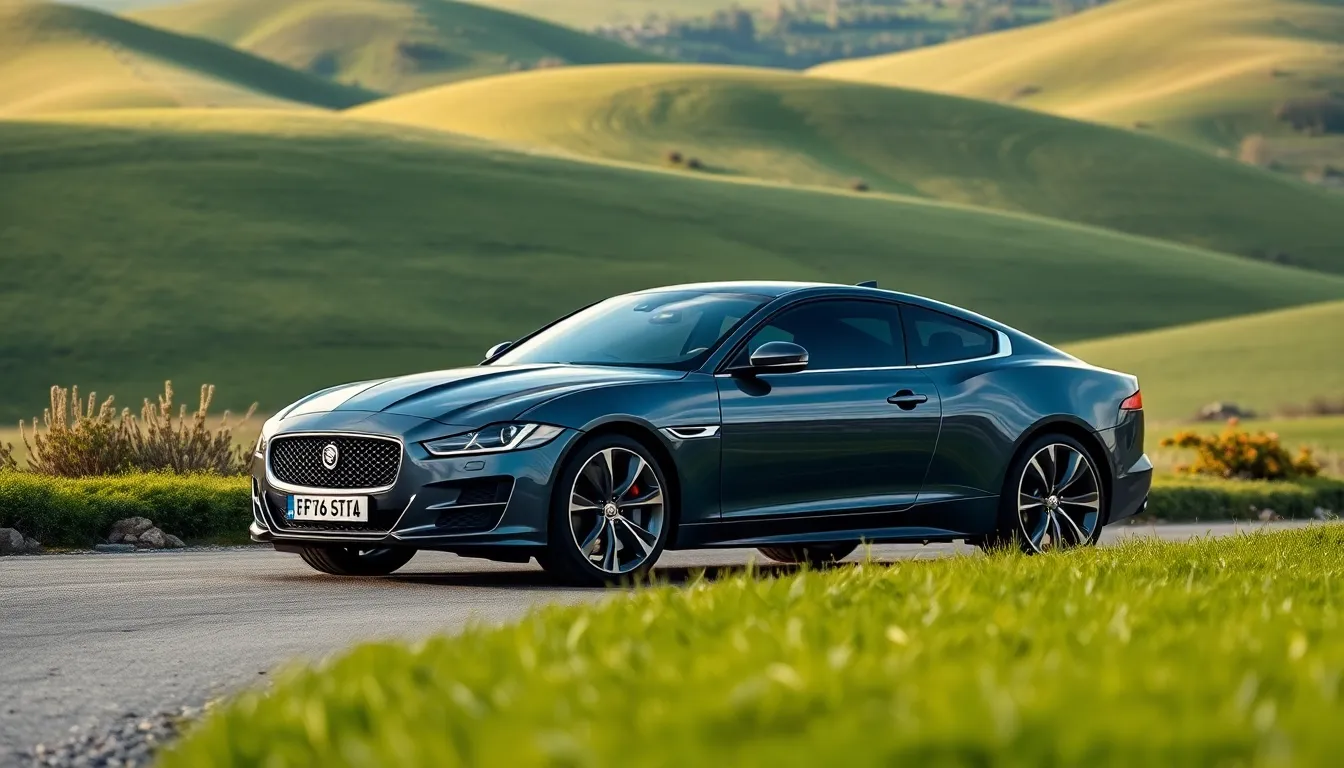
Jaguar’s aesthetic approach distinguishes itself from other luxury manufacturers through its unique blend of British craftsmanship and emotional design philosophy. We analyze how Jaguar’s visual language contrasts with major competitors in the luxury automotive segment.
Against German Luxury Brands
German luxury brands prioritize geometric precision and engineering-focused aesthetics, while Jaguar emphasizes organic flowing lines and emotional connections. BMW’s kidney grille design remains angular and structured, contrasting with Jaguar’s curved oval grille that creates a more sensual appearance. Mercedes-Benz C-Class sedans feature stark horizontal lines across their dashboards, whereas our XF models incorporate sweeping curves that guide the eye naturally through the cabin space.
Audi’s Virtual Cockpit presents information through stark digital displays, but Jaguar’s InControl Touch Pro system maintains analog elements that preserve traditional luxury craftsmanship. German interiors use synthetic materials and carbon fiber trim extensively, while we prioritize natural Oxford leather and hand-selected wood veneers from sustainable forests. BMW’s iDrive controller creates a tech-focused experience, yet our rotary gear selector rises from the center console as an elegant mechanical gesture.
Performance aesthetics differ significantly between these approaches. Porsche 911 models feature aggressive rear spoilers and geometric air intakes, while our F-Type sports cars achieve aerodynamic efficiency through muscular haunches and flowing bodywork. German brands often display their engineering prowess through visible mechanical elements, but Jaguar conceals complexity beneath smooth, uninterrupted surfaces that emphasize visual harmony.
British Heritage vs. Modern Luxury
British automotive heritage influences Jaguar’s aesthetic through traditional craftsmanship techniques and cultural references, setting us apart from contemporary luxury interpretations. Our interior designs incorporate Union Jack motifs subtly woven into seat stitching patterns, while modern luxury brands like Tesla focus on minimalist technology-driven cabins. Range Rover models share British DNA but emphasize rugged capability through squared proportions, whereas Jaguar maintains sleek proportions that prioritize elegance over utility.
Bentley represents traditional British luxury through ornate details and extensive hand-crafted elements, yet we balance heritage with contemporary restraint. Our XJ flagship features clean lines that reference classic British design without excessive ornamentation, creating timeless appeal that transcends current trends. Aston Martin pursues aggressive sports car aesthetics, but Jaguar’s approach integrates performance cues more subtly into everyday luxury vehicles.
Modern luxury brands often prioritize technology visibility over material quality, displaying large touchscreens and digital interfaces prominently. We maintain physical controls for essential functions while integrating advanced technology seamlessly into traditional luxury environments. Our I-PACE electric vehicle demonstrates this philosophy by combining sustainable materials with British craftsmanship traditions, proving that heritage enhances rather than constrains innovation.
Heritage colors distinguish our palette from modern competitors. British Racing Green connects directly to motorsport history, while contemporary luxury brands often focus on neutral metallic finishes. Our Caldera Red and Opalescent Silver Metallic options reference decades of automotive excellence, creating emotional connections that purely modern approaches cannot replicate.
The Future of Jaguar Design
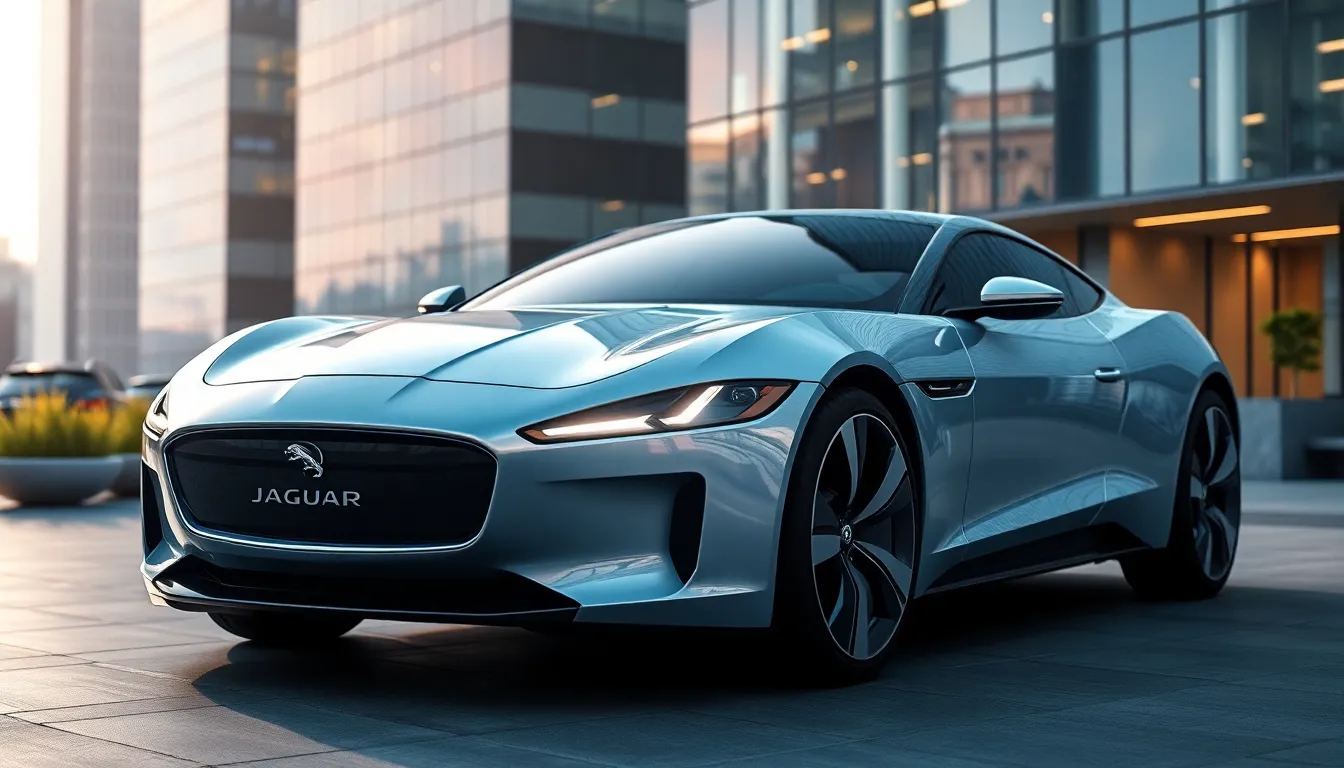
Jaguar’s design evolution accelerates toward an electrified future where sustainable luxury meets cutting-edge aesthetics. Our commitment to maintaining iconic design DNA while embracing revolutionary technologies defines the next chapter of automotive elegance.
Electric Vehicle Aesthetics
Electric powertrains fundamentally reshape Jaguar’s design philosophy by eliminating traditional grille requirements and creating opportunities for aerodynamic innovation. The I-PACE demonstrates how we reimagine classic proportions with its distinctive enclosed grille that maintains visual connection to heritage models while optimizing airflow efficiency.
Battery placement beneath the cabin floor enables lower center of gravity designs that enhance both performance characteristics and visual stance. We integrate charging ports seamlessly into body panels, preserving clean lines that define Jaguar aesthetics across generations of vehicles.
LED lighting systems replace conventional headlamp assemblies with signature daytime running lights that create unmistakable brand recognition. Digital instrument clusters expand beyond traditional analog displays while maintaining the luxurious cockpit atmosphere that distinguishes Jaguar interiors.
Aerodynamic requirements drive body sculpting decisions that reduce drag coefficients to maximize electric range capabilities. We incorporate active aerodynamic elements like deployable spoilers and air curtains that enhance efficiency without compromising the flowing silhouette that characterizes our design language.
Sustainability in Design Choices
Material selection prioritizes renewable and recycled components that maintain premium quality standards while reducing environmental impact. We source sustainable leather alternatives from innovative bio-based materials and integrate recycled aluminum components throughout vehicle structures.
Carbon fiber production utilizes renewable energy sources and recycled materials to create lightweight body panels that enhance performance metrics. Forest Stewardship Council certified wood veneers replace traditional timber selections while preserving the British craftsmanship heritage embedded in interior design philosophy.
Manufacturing processes embrace closed-loop water systems and renewable energy integration across our production facilities. We carry out advanced paint technologies that reduce volatile organic compound emissions while delivering the lustrous finishes that define Jaguar color palettes.
Digital design tools minimize physical prototype requirements during development phases, reducing material waste by 45% compared to traditional automotive design processes. Our virtual reality design studios enable comprehensive aesthetic evaluation without producing multiple test vehicles.
Packaging materials use biodegradable alternatives for component shipping and customer delivery, extending sustainability principles beyond vehicle production into every touchpoint of ownership experience.
Conclusion
When we consider Jaguar’s automotive aesthetic we’re witnessing decades of design mastery that continues to evolve while honoring its rich heritage. The brand’s commitment to blending timeless elegance with cutting-edge innovation creates vehicles that transcend mere transportation to become rolling works of art.
As Jaguar moves toward an electrified future we can expect this legendary aesthetic to adapt and flourish. The marriage of sustainable luxury materials advanced technology and those unmistakable design elements ensures that every Jaguar will continue to embody the perfect balance of British sophistication and contemporary performance.
Whether you’re drawn to the aggressive stance of the F-Type or the refined elegance of the XJ the Jaguar aesthetic remains unmatched in its ability to stir emotions and command respect on any road.
Frequently Asked Questions
What makes Jaguar’s design philosophy unique compared to other luxury car brands?
Jaguar’s design philosophy blends British elegance with emotional artistry, creating vehicles that are more than just transportation—they’re artistic creations. The brand uses mathematical principles like the golden ratio for proportions, incorporates flowing lines inspired by nature, and maintains a distinctive heritage through elements like the leaping jaguar emblem and oval grille, setting it apart from competitors’ more angular approaches.
How has Jaguar’s design evolved from classic models to modern vehicles?
Jaguar’s design evolution spans seven decades, beginning with iconic classics like the E-Type that established flowing lines and elongated hoods. The modern transformation started in 2007 under Ian Callum’s direction with the XF sedan, embracing contemporary aesthetics while preserving classic proportions. Today’s models like the F-Type and I-PACE showcase innovative technology integration while maintaining the brand’s signature elegance.
What are Jaguar’s signature design elements that appear across all models?
Key signature elements include the iconic leaping jaguar hood ornament (since 1945), the distinctive oval grille, modern LED headlight designs, and flowing body lines crafted using mathematical principles. These elements create an unmistakable visual identity that combines power, grace, and aerodynamic efficiency across the entire Jaguar lineup, from sports cars to luxury sedans.
What materials and craftsmanship define Jaguar’s interior design?
Jaguar interiors feature premium Oxford and Windsor leather, hand-selected veneers from sustainable forests, and heritage-inspired details like Union Jack motifs. The cockpit-inspired dashboard prioritizes driver accessibility with the InControl Touch Pro system. Traditional British craftsmanship techniques blend with modern manufacturing processes, creating sophisticated sanctuaries that honor Coventry origins while meeting contemporary comfort expectations.
What color options and customization does Jaguar offer?
Jaguar offers classic colors including British Racing Green, Opalescent Silver Metallic, Santorini Black, and Caldera Red, each enhancing the vehicle’s character. Modern paint technologies provide premium lustrous and metallic finishes for durability and visual impact. Special Vehicle Operations offers bespoke color matching services for unique hues, while contemporary matte finishes provide modern alternatives to traditional glossy surfaces.
How do different Jaguar models express the brand’s design DNA?
Each Jaguar category maintains core visual DNA while expressing unique characteristics. The F-Type features aggressive sports car aesthetics with muscular haunches, while the F-PACE translates this into a practical crossover package. The XF and XJ sedans represent modern executive luxury combining British elegance with contemporary trends. The I-PACE showcases forward-thinking electric design with aerodynamic efficiency and sustainable materials.
How is Jaguar adapting its design for an electrified future?
Jaguar is embracing sustainable luxury through electric powertrains that enable aerodynamic innovations and reimagined proportions, as demonstrated by the I-PACE. The brand integrates renewable and recycled materials, advanced manufacturing processes, and digital design tools to minimize waste. This approach maintains Jaguar’s organic design philosophy and emotional heritage connections while advancing toward an environmentally conscious future.

